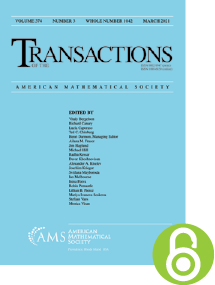Heisenberg manifolds and theta functions
HTML articles powered by AMS MathViewer
- by R. Tolimieri PDF
- Trans. Amer. Math. Soc. 239 (1978), 293-319 Request permission
Abstract:
The algebraic structure of the $(2n + 1)$-dimensional Heisenberg group naturally induces a special class of differential operators whose solutions $(Df = 0)$ are related to classical theta function theory.References
- L. Auslander and J. Brezin, Translation-invariant subspaces in $L^{2}$ of a compact nilmanifold. I, Invent. Math. 20 (1973), 1–14. MR 322100, DOI 10.1007/BF01405260
- Jun-ichi Igusa, Theta functions, Die Grundlehren der mathematischen Wissenschaften, Band 194, Springer-Verlag, New York-Heidelberg, 1972. MR 0325625, DOI 10.1007/978-3-642-65315-5
- Nathan Jacobson, Lie algebras, Interscience Tracts in Pure and Applied Mathematics, No. 10, Interscience Publishers (a division of John Wiley & Sons, Inc.), New York-London, 1962. MR 0143793
- Serge Lang, Algebra, Addison-Wesley Publishing Co., Inc., Reading, Mass., 1965. MR 0197234
- Serge Lang, Introduction to algebraic and abelian functions, Addison-Wesley Publishing Co., Inc., Reading, Mass., 1972. MR 0327780
- A. I. Mal′cev, On a class of homogeneous spaces, Izvestiya Akad. Nauk. SSSR. Ser. Mat. 13 (1949), 9–32 (Russian). MR 0028842 O. T. O’Meara, Introduction to quadratic forms, Springer, Berlin, 1963. C. L. Siegel, Quadratic forms, Lectures on Math., no. 7, Tata Institute of Fundamental Research, Bombay, 1967.
Additional Information
- © Copyright 1978 American Mathematical Society
- Journal: Trans. Amer. Math. Soc. 239 (1978), 293-319
- MSC: Primary 22E25; Secondary 14K25, 33A75, 43A85
- DOI: https://doi.org/10.1090/S0002-9947-1978-0487050-7
- MathSciNet review: 487050


